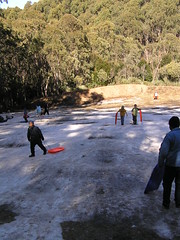We’ve seen a fair bit of Picasso, or rather his work, in Spain. Both Barcelona and Madrid have some pretty impressive paintings, particularly Guernica. That work falls in the period of Picasso’s life, 1935-1945, being focussed on in the NGV’s current exhibition …
Picasso – Love & War
Dora Maar was an absurdist photographer, and one of Picasso’s mistresses. She also hung onto a lot of stuff. When she passed away in 1997, the contents of her apartment turned out to be a veritable timecapsule. The scholarship that has resulted from the study of her treasure-trove led to this current exhibit. It’s her photos of him, his paintings of her, her knick-knacks that he’s scribbed on, his works-in-progress that she’s captured on film, etc.
The strange thing is that this exhibition is so obviously full of joint works, but Picasso has taken the title. This slight to Maar aside, it’s up to the NGV’s usual standard, and again shows their skill in taking an assorted collection of pieces, a few clear masterpieces (most in their permanent collection anyway), and creates something more than the sum of its parts.
If you’d like to learn about an interesting abstract artist you’ve probably never heard of, and learn some new things about an interesting abstract artist you’re probably sick of hearing about, then this is the show for you.
My rating: stars
![]()
![]()
![]()
![]()
![]()
